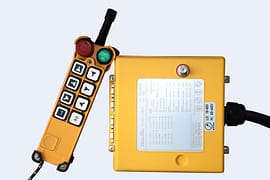The Difference of Hoists and Cranes(With Common Types)
What is a hoist?

A hoist is a type of lifting equipment. The components of a hoist (taking an electric wire rope hoist as an example) include an electric motor, a reducer, a brake, a drum, a wire rope, and a hook, among others.
A single hoist can be fixedly installed at a high place (such as a roof) to carry out the lifting and lowering of heavy objects at that location.
When a hoist is equipped with a trolley, it can be installed on a beam or track, allowing the hoist not only to lift and lower heavy objects but also to move left and right along the beam or track.
Common types of hoists include manual chain hoists, electric wire rope hoists, and electric chain hoists.
Manual hoists, also called hand hoists, lift heavy objects through human power, with low lifting efficiency. They are simple in design, easy to inspect, maintain, and clean. Their compact design allows them to be used in narrow spaces or applications without electricity.
Electric hoists lift heavy objects through electricity, with high lifting efficiency, and common types include electric wire rope hoists and electric chain hoists. Electric wire rope hoists are faster, operate more quietly and smoothly, and dominate the market for capacities of 10 tons and above. Electric chain hoists, compared to electric wire rope hoists, have more durable chains, occupy less space, and are more affordable, often used in light applications below 5 tons.
What is a crane ?

Cranes are large lifting equipment. The components of a crane (taking the single girder overhead crane shown in the illustration as an example) include the main beam, end beam, hoist, and other parts.
Cranes can not only lift objects but also move them over large areas. The crane shown above is a gantry crane, which can move back and forth along tracks on the ground. The hoist mounted on the crane can move left and right along the main beam, and it can move heavy objects up and down. Therefore, this crane can move heavy objects in three dimensions: forward and backward, left and right, and up and down.
There are many types of cranes, including overhead(bridge)cranes, gantry cranes, jib cranes, and monorail cranes. Bridge cranes are usually used indoors in factories and workshops; gantry cranes are typically used for outdoor operations; jib cranes can perform lifting tasks well in confined spaces and are an ideal low-cost lifting choice in factories. Monorail cranes are fully adaptable to production facilities of any scale or shape and can be used in spaces where bridge cranes cannot travel.
Why do we often confuse the differences between hoists and cranes?
The confusion between hoists and cranes, or the use of the term “hoist” to describe an entire lifting system, stems from a few factors:
Firstly, there is a lack of clear understanding about hoists and cranes. Sometimes translation software provides the same translation for these two terms, which can easily lead to confusion.
Secondly, they do have similarities, but upon closer examination, you’ll find that they differ significantly in appearance, function, and application scenarios.
Similarities of hoists and cranes:
- Both hoists and cranes can be used independently as lifting equipment.
- Both hoists and cranes come in manual and electric varieties.
Differences of hoists and cranes:
- Flexibility in operation:
Cranes can be equipped with various lifting tools and attachments to perform different tasks. A hoist is one such tool.
- Working range:
Hoists are suitable for smaller work range vertical lifting operations, while cranes are suitable for lifting and moving operations in large and varying work environments. For example, eot cranes and gantry cranes can cover a rectangular area’s movement range up and down, left and right, forward and backward.
- Applicability:
Hoists are very suitable for vertical material lifting operations in limited spaces such as factories and warehouses.
Cranes, on the other hand, typically have a larger load capacity and are suitable for large-scale industrial and construction activities. They are often used at construction sites, freight terminals, and large industrial and mining enterprises.
Understanding the differences between hoists and cranes can help you select the most appropriate lifting equipment for your factory or workshop. It also enables clearer and more accurate communication with manufacturers about your needs. I trust that through this article, everyone can now understand the distinctions between hoists and cranes. If there are any further questions, please feel free to contact me. I am happy to clarify any doubts.
























































































































